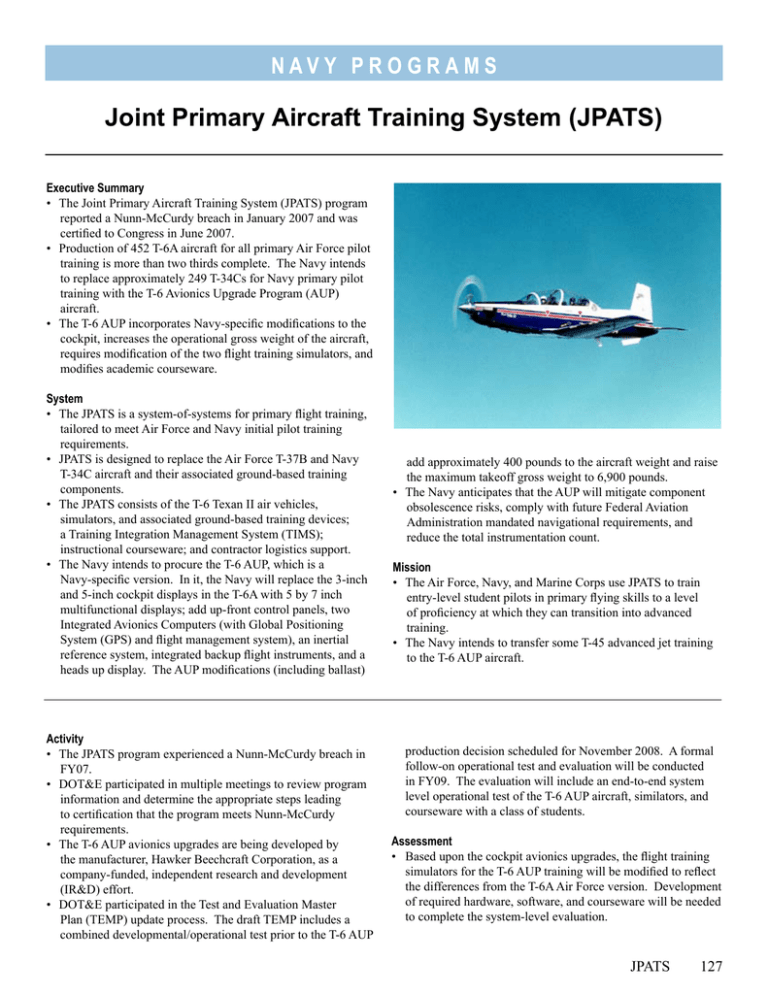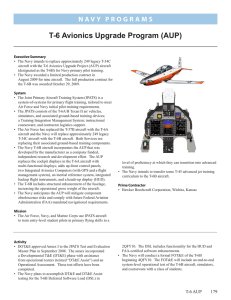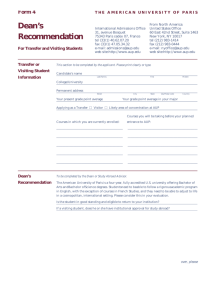Joint Primary Aircraft Training System (JPATS)
advertisement

N av y P R O G R A M S Joint Primary Aircraft Training System (JPATS) Executive Summary • The Joint Primary Aircraft Training System (JPATS) program reported a Nunn-McCurdy breach in January 2007 and was certified to Congress in June 2007. • Production of 452 T-6A aircraft for all primary Air Force pilot training is more than two thirds complete. The Navy intends to replace approximately 249 T-34Cs for Navy primary pilot training with the T-6 Avionics Upgrade Program (AUP) aircraft. • The T-6 AUP incorporates Navy-specific modifications to the cockpit, increases the operational gross weight of the aircraft, requires modification of the two flight training simulators, and modifies academic courseware. System • The JPATS is a system-of-systems for primary flight training, tailored to meet Air Force and Navy initial pilot training requirements. • JPATS is designed to replace the Air Force T-37B and Navy T-34C aircraft and their associated ground-based training components. • The JPATS consists of the T-6 Texan II air vehicles, simulators, and associated ground-based training devices; a Training Integration Management System (TIMS); instructional courseware; and contractor logistics support. • The Navy intends to procure the T-6 AUP, which is a Navy-specific version. In it, the Navy will replace the 3-inch and 5-inch cockpit displays in the T-6A with 5 by 7 inch multifunctional displays; add up-front control panels, two Integrated Avionics Computers (with Global Positioning System (GPS) and flight management system), an inertial reference system, integrated backup flight instruments, and a heads up display. The AUP modifications (including ballast) Activity • The JPATS program experienced a Nunn-McCurdy breach in FY07. • DOT&E participated in multiple meetings to review program information and determine the appropriate steps leading to certification that the program meets Nunn-McCurdy requirements. • The T-6 AUP avionics upgrades are being developed by the manufacturer, Hawker Beechcraft Corporation, as a company‑funded, independent research and development (IR&D) effort. • DOT&E participated in the Test and Evaluation Master Plan (TEMP) update process. The draft TEMP includes a combined developmental/operational test prior to the T-6 AUP add approximately 400 pounds to the aircraft weight and raise the maximum takeoff gross weight to 6,900 pounds. • The Navy anticipates that the AUP will mitigate component obsolescence risks, comply with future Federal Aviation Administration mandated navigational requirements, and reduce the total instrumentation count. Mission • The Air Force, Navy, and Marine Corps use JPATS to train entry-level student pilots in primary flying skills to a level of proficiency at which they can transition into advanced training. • The Navy intends to transfer some T-45 advanced jet training to the T-6 AUP aircraft. production decision scheduled for November 2008. A formal follow-on operational test and evaluation will be conducted in FY09. The evaluation will include an end-to-end system level operational test of the T-6 AUP aircraft, similators, and courseware with a class of students. Assessment • Based upon the cockpit avionics upgrades, the flight training simulators for the T-6 AUP training will be modified to reflect the differences from the T-6A Air Force version. Development of required hardware, software, and courseware will be needed to complete the system-level evaluation. JPATS 127 N av y P R O G R A M S • The Navy intends to award a production contract for the T-6 AUP variant in November 2008 if the cost, schedule, and performance requirements are met. Recommendations • Status of Previous Recommendations: There are no previous recommendations. 128 JPATS • FY07 Recommendation. 1. The Navy should conduct a combined developmental/ operational test to support the T-6 AUP production decision.





